|
Contracts,
contracts, and more contracts
|
©2006
Fred Tepfer
1380
Bailey Avenue Eugene, OR 97402
non-commercial use freely granted
|
Contracts
and contracting isn't the most interesting area of facilities,
but it has a large potential for harm. Ignore these issues
at your own peril; you may find your name in headlines if
you do not. As a steward of the public trust, contracts are
your basic tools to ensure that your taxpayers dollars are
spent appropriately and effectively.
Rules
for construction contracting vary from place to place. It
is important to find out not only what local laws regulate
your contracts but also what the local construction industry
is familiar with.
PART 1: ARCHITECT AND ENGINEER CONTRACTS
HIRING
Projects begin with planning, then move into design and construction. As this
process progresses there is more and more certainty about the parameters of
the project, what it consists of, where and when it will be built, how it will
be paid for. Often, to begin this process, a planning study or project definition
study must be done even before you know that you want to build. These initial
contracts are often small, but still would fit into the category of architect
and engineer contracts.
School districts are famous for making hash of the architect hiring process.
The classic horror story is that the district starts the hiring process wanting
to save a great deal on fee, and hires the architect whose proposed fee is lowest.
Said architect gives relatively poor service, as per their compensation. Owner,
near the end of the process, feels wronged by lack of choices, poor design,
hasty construction documents, or whatever, and sues architect.
How can this nightmare be avoided? Most larger government agencies, as well
as the Federal government, use some form of qualification-based selection process.
In this process, the owner hires following these steps (or some variation of
them):
- The school or district establishes a hiring committee
and procedures. The committee prepares information describing the project
(a request for proposals, or RFP), the site, the budget, and any other pertinent
information. This may require some work. The district may want to hire an
educational facilities planner to help with this process. If the district
has determined that a certain fee is reasonable for this work, the fee is
described as well. It is made clear that this is not a design competition,
and that design will not begin until after a contract has been signed.
- In response to advertisements, architects submit
proposals. The district reviews those proposals accrording to the criteria
outlined in the RFP, either using a point system or at least by documenting
their reasons, which most often relate to experience, size, availability,
proximity, or references.
- A certain number of firms are invited to an interview
(usually at least three, most often no more than five or seven). If references
weren't checked when the proposals were reviewed, it is important to check
them now, and to forward the information to the committee members (see References,
below).
- After the interviews (usually 30-60 minutes in length),
the committee deliberates, and, documenting why, forwards a recommended list
of firms in rank order to the district.
- The district negotiates fee and service level with
the preferred firm. If they are unable to come to terms, the district breaks
off negotiations and begins negotiating with the second firm. During this
process, it is important for both sides to understand the expectations and
committments. Sometimes architecture firms offer services which the owner
neither wants nor is willing to pay for. Other times, the owner expects certain
services to be included in the architects proposal which may not be there.
REFERENCES
Reference checking is a fine art. It is wise to make more than one check on
each firm, and at least one of those should be a reference not listed in the
firm's proposal. Make sure that the project references checked were the work
of the same people in the firm, as a firm's performance can vary widely depending
on the personnel assigned to the project.
References can prevent you from hiring a firm that would be a bad fit for your
project. They can also warn you about weak points in a firm that you might be
about to hire. For example, if you find that an otherwise excellent firm has
an unfortunate tendency to change the personnel assigned to a project while
it is underway, you may want to include a clause in their contract that prevents
them from doing that without your permission (naming the people by name).
One bad reference need not prevent you from hiring a firm. Every firm has a
project that has gone sour. If you do get a bad reference, it is important to
continue checking until you are confident of the pattern that is emerging. What
is this firm like? Do you want to work with them? What are their strengths and
weaknesses?
Remember that reference information is confidential. It is considered very
unprofessional to discuss a reference conversation with an outside party who
is not part of the hiring committee.
The following reference check questions were developed at the University of
Oregon Planning Office.
This is a completely unstructured, free-form list, best used after reading
and selecting those questions that are meaningful for your project.
- REFERENCE QUESTIONS FOR PROSPECTIVE CONSULTANTS
- - Get name, position, and current status
of person being interviewed.
- - How many projects have you worked on
in which this firm has been involved? Size of project? Budget? Dates?
- - How did you come to select this architectural
firm?
- - Who were the principals in the firm
most directly involved in your project?
- - At what point did you become involved
in this project? In what capacity?
- - Did you deal with the architects directly?
Who talked with the architects? (How many meetings? / How often?)
- - Were you part of a team, committee,
user group, a principal?
- - Do you have a standard design and planning
process?
- - Was the firm (or its principals)
- - Easy to work with?
- - Concerned with your needs to the expected
degree?
- - Good listeners?
- - Good advocates for the owner before
contractors, public bodies, etc.?
- - Good at recovering from mistakes?
- - Did you get what was promised in the
interview? People/Process/Product?
- -
Was the design team consistent?
- - Did they see the project all the
way through to completion and during the "break-in" period?
- - What was the biggest architectural problem
you faced upon beginning the
- project? Did the firm resolve this problem
to your satisfaction?
- - Did the architect recommend any unconventional
building techniques or materials? Were these successful? If not, how much
of that responsibility is the architect's?
- - Were there any surprises regarding their
fees? Any unexpected extra charges?
- - Did the architect's estimates come close
to the actual bids?
- - How was the quality of their work with
their consultants?
- - Do you like the building? Does it work
as it ought to? Did you get the building you thought you were buying?
- - What don't you like about your building?
To what degree is that the architect's fault?
- - What do you feel the general over-all
reaction has been to the project? Have you received any public feed-back?
- - What was the biggest trouble in working
with these architects? Were there any hassles or arguments that were difficult
to resolve?
- - Who else should I talk to who can tell
me more on these architects?
- - Have you hired this firm again?
- - Would you hire them again?
- - Make an offer to someday reciprocate
the reference.
WHAT'S IN A CONTRACT?
It is very important for a contract to clearly spell out what is expected of
each party. Here are a few questions that should be considered. How much is
the compensation, and at how and when does payment occur? How and when can the
contract be terminated? What are the basic services covered? How are extra services
(for extra fee) incurred? Who has what rights to the plans or other product?
Is the owner responsible for all survey information (incuding information about
existing buildings)? If the bid price exceeds the estimate by a certain percentage,
will the architect or engineer modify the plans and specifications to bring
the project within budget without charge to the owner?
TRADITIONAL OWNER/ARCHITECT AGREEMENT
| In this arrangement, the owner has a contract with the architect. All
of the other design professionals have contracts with the architect. The
architect has full responsibility to the owner for all design responsibilities. Advantages: • Owner
only needs to deal with one entity, the architect. Disadvantages: • Architect
may want to use engineering or other consultants
that the owner doesn't want. • Owner
doesn't have direct access to some team members.
All information is filtered through the architect. |
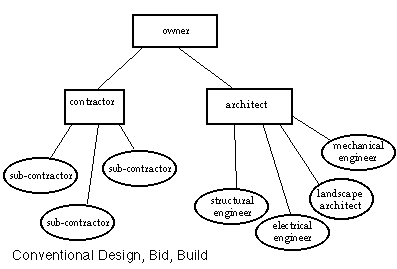 |
MULTI-PRIME AGREEMENTS
| Multi-prime agreements are sometimes
used in large or very specialized work. In these agreements, the owner has
separate contracts with some or all members of the design team. Some firms
may have subcontracts with a prime firm (as the landscape architect in the
example above). In most cases, the owner has hired these firms separately
and has imposed a team structure on the players. Each professional firm
that has a contract with the owner has direct responsibility to the owner.
The architect's contract usually includes a requirement that they coordinate
the work of all of the other firms, but since they have no contractual relationship
with some of the other team members, the owner may have to arbitrate disputes. |
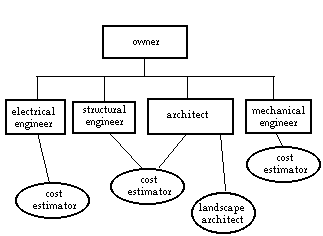 |
| Advantages: • Owner
can select team members that they want. • Critical
team members can be directly responsible to the owner. |
Disadvantages: • Responsibilities
may be confused, especially in the area of coordination. • Owner
is the only means of resolving disputes between team
members. |
RETAINER AGREEMENTS
Some owners maintain
retainer agreements with architects, engineers, or landscape
architects. These are especially useful for small projects
or emergency work, as the contract is already in place,
and no hiring process other than agreement on fee is required
before undertaking a project. If you use retainer agreements,
it is important to limit their duration (usually one to
three years). It is probably a good idea to "spread the work around" either
with retainer agreements with more than one firm at a time,
or changing from one firm to another, in order to foster
a competitve environment.
PART
2: CONSTRUCTION CONTRACTS
Construction contracts can be structured in a wide variety of ways, some of which are discussed below. Before choosing one of these, it is important to learn what the legal requirements are for your schools, and what arrangements have or have not been successful in the recent past. Generally speaking, the construction industry will be leery of using a contracting arrangement that has had a bad track record.
No matter what
the contract structure, it is extremely important that
all responsibilities be spelled out in the construction documents.
These consist not only of the design team's drawings and
specifications but also the "front end", which includes
the advertisement for bid, requirements for bid bond, performance
bond (if required), prevailing wage rates (often required
on government work), and especially the general conditions.
The general condtions describe the roles and responsibilities
of the owner, contractor, and architect. There are many
model general conditions available. Not unexpectedly, they
tend to be written to protect the interests of whoever
wrote them. For many years, the American Institute of Architects
set of general conditions and other contracting forms was
the industry standard, but recent versions are perceived
by some facility managers as written to protect the architect
in the event of a dispute.
Generally speaking, it is wise to either use a standard form such as those available from the AIA (American Institute of Architects), a model general conditions produced by government agencies in your area, or have an attorney specializing in construction law create general conditions for your use. THIS IS NOT A DO-IT-YOURSELF OPERATION.
CONVENTIONAL DESIGN, BID, BUILD
| This is the traditional
arrangement in modern American construction. The owner hires an architect
who prepares plans and specifications. A contract is awarded from the owner
to the contractor who offers to build the work for the lowest price.
Advantages:
- It's
simple.
- Everyone
is familiar with the process and the relationships.
Disadvantages:
- Contractor's can offer an artificially low bid,
then find ways of charging exhorbitant amounts for extras during construction.
- Design team can't take advantage of the expertise
of the contractor during design.
|  |
| |
NEGOTIATED BID
This arrangement is the same as traditional Design, Bid, Build, except that
rather than take bids from contractors, an owner negotiates a price with a contractor
selected on the basis of other criteria such as experience. In some cases, the
negotiation process starts early in the design process, and the contractor becomes
part of the design team (see also Construction Management/General Contracting).
Advantages:
- Expertise
of contractor during design.
- Excellent control over costs.
Disadvantages
- Not allowed under most public bidding law.
- Depends on all parties (architect, owner, contractor)
acting in good faith.
DESIGN-BUILD
| Design build is based on maximizing cooperation and efficiency between
contractor and architect, somewhat at the cost of owner control over design.
After preparing a preliminary description of the project (but not designing
it), the owner solicits proposals from contractor-architect teams. These
proposals, which consist of a preliminary design plus a proposed price,
are evaluated with a point system specified in advance, and the selected
team (usually with the contractor as prime) designs and builds the project
to the criteria specified in the original solicitation. |
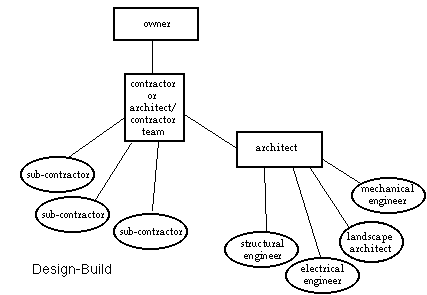 |
CONSTRUCTION MANAGEMENT
| In construction management,
the owner hires a construction manager to assist with day-to-day dealings
with the contractor and architect, freeing the owner from many management
responsibilities. However, since there is no contractual relationship between
the construction manager and the architect or the contractor, the owner
generally finds it necessary to be directly represented in many if not most
meetings. Larger organizations generally have a construction manager (or
inspector or clerk-of-the-works) on their own staff who fills this function.
Smaller entities may want to hire a construction manager as a temporary
employe rather than as a consultant.
Advantages:
- Owner
is insulated from day-to-day management of project
- Construction
manager's expertise may reduce costs or increase
quality.
|
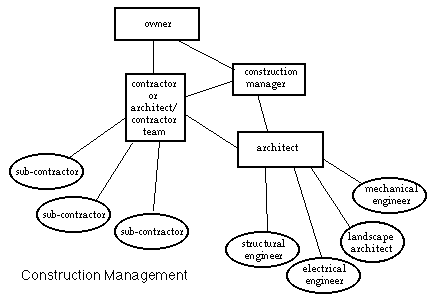 |
Disadvantages:
- Lines of responsibility between architect, owner,
and contractor are blurred by a third party giving direction but with no contractual
authority.
- Added level of management may be costly.
WHOLE PROJECT MANAGEMENT
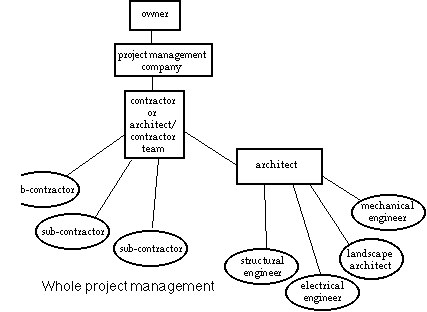
It is also possible to hire a management firm to handle the entire design and construction process. They, as owner's agent, hire an architect, direct them during the design process, manage construction, etc. This comes with certain costs. Typically, management costs are higher and owner control are lower than with traditional project development.
CONSTRUCTION MANAGEMENT/GENERAL CONTRACTING (CM/GC)
CM/GC is an attempt to have the advantges of the participation of the contractor's expertise during the design process, while still meeting public bidding requirements. In it, the contractor is selected early in the design process in much the same way as the architect (based on qualifications, references, etc), although price is also usually part of the criteria. Owner, architect, and contractor then negotiate a Guaranteed Maximum Price (GMP) for the construction.
Price is included as two factors. One is the amount of contractor fee, usually expressed as mark-up on the subcontracts. The other is the amount of the contractor's fee that would be incurred if the contractor and owner are unable to agree on a GMP.
RESOURCES:
Current edition of contracts for construction; American Institute of Architects
Local members of the Construction Specifications Institute
State model public agency contracting rules
updated 12/05
return to reading index
::::::::::::return to Fred
Tepfer's home page:::::::: return to School Facilities
Reading:::::::::::::::




